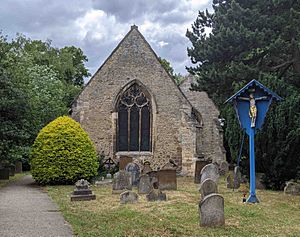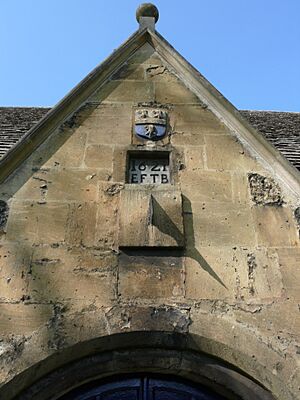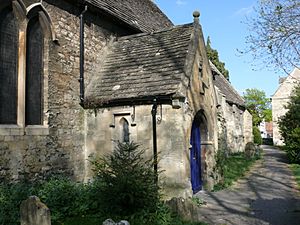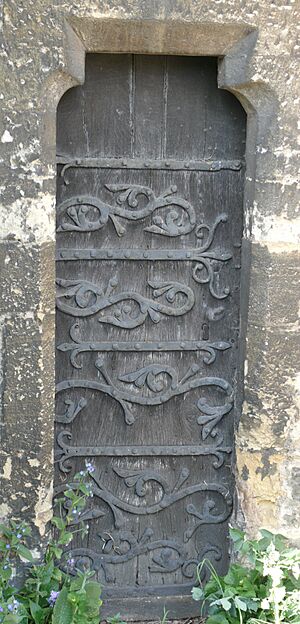St Thomas the Martyr's Church, Oxford facts for kids
Quick facts for kids St Thomas the Martyr Church, Oxford |
|
|---|---|

The east end of the church
|
|
| Country | United Kingdom |
| Denomination | Church of England |
| Churchmanship | Anglo-Catholic |
| History | |
| Founded | 12th century |
| Dedication | Thomas Becket |
| Administration | |
| Diocese | Oxford |
| Province | Canterbury |
St Thomas the Martyr Church is an old and important Church of England parish church in Oxford, England. It follows the Anglo-Catholic tradition, which means it keeps some older Christian practices. You can find it near the Oxford railway station in an area called Osney.
Contents
About the Church
This church was first built in the 1100s. It was named after Saint Thomas Becket. Even though it's very old, parts of the original building are still there. Over the years, the church has been made bigger and fixed up many times. Big changes happened in the 1600s and 1800s.
The church was very important for the start of the Oxford Movement. This was a group of people who wanted to bring back older traditions to the Church of England. At St Thomas's, they held daily services. They also used special practices like lighting candles on the altar and wearing special robes called vestments during services. Many leaders of the Oxford Movement preached here.
A Look Back in Time
How the Church Began
People in Osney used to think the church started when King Stephen was in charge. But this isn't likely, because Thomas Becket wasn't killed until much later. We know that around the 1180s, the land was given to the monks of Osney Abbey nearby. A small chapel was built there around 1190.
By the mid-1200s, the Osney area was known as the parish of St Thomas'. It was still part of the abbey until King Henry VIII closed down the monasteries. Then, the church became part of Christ Church, Oxford. Christ Church treated it like a regular parish church with a curate (a type of priest). Later, in the mid-1800s, the priest in charge was called a vicar.
From 1616 to 1640, Robert Burton, a famous writer, was the priest here. He made the church bigger. During the English Civil War, the beautiful stained glass windows were broken. This happened partly because soldiers captured in Cirencester were held prisoner in the church. After the war, many different priests took charge for short times. For a long time, money from renting a house helped pay for church repairs.
Changes in the 1800s and 1900s
By the early 1800s, the church and its area were not doing well. Not many people went to church. The parish also became smaller as new churches were built nearby.
A priest named John Jones helped turn things around from 1823 to 1842. He even got a houseboat in 1839! This boat, called the "Boatmans' Floating Chapel," was used as a church for families working on the river and canal. It was the first "chapel of ease" for St Thomas', meaning a smaller church for people who couldn't easily get to the main one. This boat was used until it sank in 1868.
Big repairs started in 1825. The church floor was raised to stop flooding. The roof was rebuilt, and the south wall was fixed.
The vicar from 1842 to 1892 was Thomas Chamberlain. He strongly believed in the Oxford Movement. He started daily services and brought back practices like altar candles and special robes. Other important leaders of the Oxford Movement, like Edward Bouverie Pusey and Henry Parry Liddon, also preached at St Thomas'.
In 1847, Chamberlain started the Community of St Thomas Martyr. This group of sisters helped the poor people in the area. They worked until 1958. New parts were added to the church building, like a new north aisle in 1846.
Later, in 1897, the church got a new roof. St Thomas' was officially recognized as an "ancient parish" in 1948.
The Church Today
For a while, St Thomas the Martyr Church had decided not to have women priests. However, in 2023, the church council voted to welcome women priests and bishops.
In 2015, St Thomas' parish joined with the nearby St Barnabas, Oxford. Now they form a new parish. St Barnabas is the main church, and St Thomas' is a chapel of ease.
Church Design and Features

The church has a main area called the nave, a north aisle (a side section), and a small room called a vestry. It also has a tall, square tower at the west end. This tower is in the Perpendicular Gothic style. There's also a chancel (the part of the church near the altar) and a south porch.
The nave was rebuilt in the late 1400s or early 1500s. The south side of the nave has old stone supports called buttresses from the 1200s. The north aisle was first built in the 1200s and rebuilt in the 1800s. The vestry was built in the 1600s and rebuilt in 1846. The church roof has been replaced at least twice.
The chancel has a beautiful ceiling decorated by Charles Eamer Kempe. It has three windows from the late 1100s. There's also a special door for the priest built around 1250. A south porch was added in 1621 by Dr Robert Burton. You can see his family's coat of arms carved above the date. A large candle holder given in 1705 hangs in the chancel. In 1914, the chancel ceiling was painted with gold stars on a blue background.
St Thomas' church has been a Grade II listed building since 1954. This means it's an important historic building.
In the churchyard, there's Combe House, which was built as a school in 1702. There's also a vicarage (the priest's house) designed in 1893.
The pulpit (where the priest gives sermons) was carved by James Rogers. He also carved many of the ends of the pews (church benches).
Images for kids







